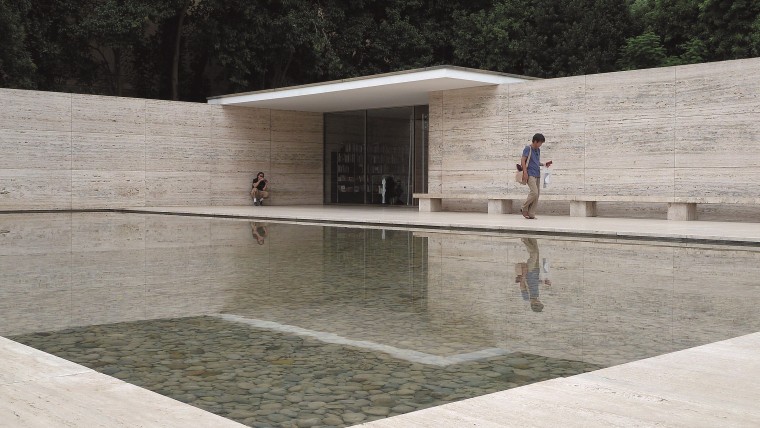Pavelló Mies van der Rohe - Institut Municipal Fundació Mies van der Rohe
Avinguda de Francesc Ferrer i Guàrdia, 7

The Mies van der Rohe Pavilion, faithful to the architects philosophy of simplicity and minimalism, occupies a small, discreet spot within the enormous Montjuïc Park, but it is of world-wide architectural and artistic importance. Its Foundation is dedicated to promoting the work of the artist and the debate on architecture in the city.
An architectural landmark
Also known as the Pavelló Alemany (German Pavilion), the Mies van der Rohe Pavilion,hidden away in a corner of Montjuic Park,is a world famous construction and architectural landmark from the early avant-garde period of the 1920s. The architect Mies van der Rohe, who was also director of the Bauhaus, designed this building to represent Germany in the Barcelona International Exposition of 1929. Known as the father of modern architecture, Van der Rohe incorporated in the design of this building the basis of his philosophy: perfect symmetry, translucent spaces, clarity, simplicity and minimalism. This is how he wanted to represent the Germany of the Weimar Republic following the First World War, and this building was intended to be a symbol of all these elements.
Faithful design
The pavilion was removed in 1930 and in 1989 it was decided to reconstruct it due to the importance of its design as a piece of modern architecture.The four different types of marble originally used, Roman travertine, green marble from the Alps, ancient green marble from Greece and golden onyx from the Atlas Mountains, were also used in the reconstruction, along with the sculpture of George Kolbe strategically located next to the pond, playing with the light and reflections of the water. Currently home to a Foundation, the building is open to the public and is mainly dedicated to disseminating the work of the architect and to promoting the debate on architecture and modern and contemporary art.




Cultural heritage
-
Sants-Montjuïc
el Poble-sec
-
- Phone number
- Tel.: 932151011
-
- Web
- http://miesbcn.com/ca Open in a new window
-
- E-mail
- pavello@miesbcn.com
-
- Titularity
- Public center
- Address:
- Avinguda de Francesc Ferrer i Guàrdia, 7
- Districte:
- Sants-Montjuïc
- Neighborhood:
- el Poble-sec
- City:
- Barcelona
Timetable
| Periode | Dies | Hores | Preus |
|---|---|---|---|
| De l'1 març al 31 octubre | Cada dia Dies de tancament: 26 d'abril (dissabte), 29 d'abril (dimarts), 5 de maig (dilluns), 8 de maig (dijous), 10 de maig (dissabte), 14 de maig (dimecres), 20 de maig (dimarts), 22 de maig (dijous), 23 de maig (divendres), 28 de maig (dimecres), 29 de maig (dijous) |
de 10:00 h a 20:00 h | Entrada general: 9 € . Reduïda: 5 € -estudiants -persones a l'atur -targeta rosa reduïda -targeta família nombrosa . Grups: 7 € per persona (mínim 15 persones i amb reserva prèvia obligatòria) . 25 % descomptes -tiquet bus turístic -targeta Bcn Card -tiquet Barcelona City Tour -arquitectes col·legiats al COAC -membres Docomomo internacional . Gratuïta: -primer diumenge de mes -menors de 16 anys -carnet de l'ICOM -guies turístics professionals i periodistes exercint la professió -Passi Metropolità d'Acompanyant d'un Discapacitat -professors d'ensenyament reglat amb grup d'alumnes -carnet Associació Museòlegs de Catalunya -targeta rosa gratuïta -estudiants de primària, secundària, batxillerat i cicles formatius de centres educatius catalans en visita concertada en horari lectiu -titulars de la targeta acreditativa de discapacitat de la Generalitat de Catalunya (en cas de barem de tercera persona reconegut, l’acompanyant també entra gratuïtament) -9 de febrer (Santa Eulàlia) -23 d'abril (Sant Jordi) -24 de setembre (La Mercè) -7 i 8 octubre (Viu Montjuic. El Parc de la Cultura) Visita especialitzada d'arquitectura: 115 €. Servei de visita guiada privativa per un màxim de 25 persones i amb reserva prèvia obligatòria. |
La Nit dels Museus 2024: 18 de maig |
de 19.00 h a 01.00 h | Entrada Gratuïta |
|
| De l'1 novembre al 28 febrer | Cada dia | de 10:00 h a 18:00 h | Entrada general: 9 € . Reduïda: 5 € -estudiants -persones a l'atur -targeta rosa reduïda -targeta família nombrosa . Grups: 7 € per persona (mínim 15 persones i amb reserva prèvia obligatòria) . 25 % descomptes -tiquet bus turístic -targeta Bcn Card -tiquet Barcelona City Tour -arquitectes col·legiats al COAC -membres Docomomo internacional . Gratuïta: -primer diumenge de mes -menors de 16 anys -carnet de l'ICOM -guies turístics professionals i periodistes exercint la professió -Passi Metropolità d'Acompanyant d'un Discapacitat -professors d'ensenyament reglat amb grup d'alumnes -carnet Associació Museòlegs de Catalunya -targeta rosa gratuïta -estudiants de primària, secundària, batxillerat i cicles formatius de centres educatius catalans en visita concertada en horari lectiu -titulars de la targeta acreditativa de discapacitat de la Generalitat de Catalunya (en cas de barem de tercera persona reconegut, l’acompanyant també entra gratuïtament) -9 de febrer (Santa Eulàlia) -23 d'abril (Sant Jordi) -24 de setembre (La Mercè) -7 i 8 octubre (Viu Montjuic. El Parc de la Cultura) Visita especialitzada d'arquitectura: 115 €. Servei de visita guiada privativa per un màxim de 25 persones i amb reserva prèvia obligatòria. |
Construït per a l'Exposició Universal de Barcelona de 1929, un cop acabada la mostra es va desmuntar. Posteriorment, l'any 1983, va ser reconstruït en el mateix emplaçament seguint el projecte original de l'arquitecte Ludwig Mies van der Rohe i es va inaugurar l'any 1986.
Esdeveniments
-
Visites al Pavelló Mies Van Der Rohe Open in a new window
Permanent event
If you would like to make a correction related to this activity...
LET US KNOW
